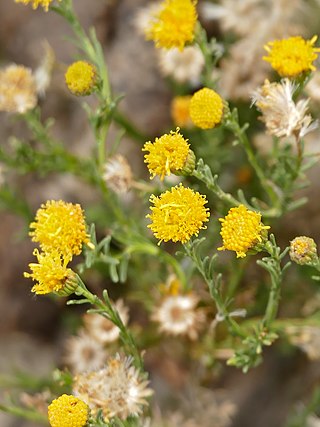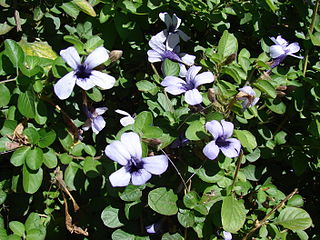
Cucumis is a genus of twining, tendril-bearing plants in the family Cucurbitaceae which includes the cucumber, true melons, the horned melon, and the West Indian gherkin.

Boswellia is a genus of trees in the order Sapindales, known for its fragrant resin. The biblical incense frankincense is an extract from the resin of the tree Boswellia sacra, and is now produced also from B. frereana. Boswellia species are moderate-sized flowering plants, including both trees and shrubs.

The genus of the myrrhs, Commiphora, is the most species-rich genus of flowering plants in the frankincense and myrrh family, Burseraceae. The genus contains approximately 190 species of shrubs and trees, which are distributed throughout the (sub-) tropical regions of Africa, the western Indian Ocean islands, the Arabian Peninsula, India, and South America. The genus is drought-tolerant and common throughout the xerophytic scrub, seasonally dry tropical forests, and woodlands of these regions.

Hypoestes is a flowering plant genus of about 150 species. They are widely distributed throughout the tropical and subtropical lands around the Indian Ocean, and some adjacent regions.

Ledebouria is a genus of African bulbous perennial herbs in the Asparagus family, Asparagaceae, subfamily Scilloideae. Most members were previously part of the genus Scilla. A number of species are grown by cacti and succulent enthusiasts for their patterned leaves.

Chapmannia is a genus of flowering plants in the family Fabaceae. It contains seven species with a scattered distribution – Mexico, Guatemala, Florida, and Venezuela in the Americas, and Somalia and Socotra in eastern Africa. The genus was recently assigned to the informal monophyletic Pterocarpus clade of the Dalbergieae.
Ormocarpum is a genus of flowering plants in the legume family, Fabaceae. It includes 17 species native to tropical and southern Africa and parts of India, Indochina, Malesia, Papuasia, and the South Pacific. The genus was recently assigned to the informal monophyletic Dalbergia clade of the Dalbergieae.
Taverniera is a genus of legume in the family Fabaceae. It includes 17 species of shrubs or shrublets which range from Egypt eastwards to the Arabian Peninsula, Iraq, Iran, Pakistan, and India, and southwards to Ethiopia and Somalia. Typical habitats include seasonally-dry tropical and subtropical desert, shrubland, and bushland.

Pentzia is a genus of African plants in the chamomile tribe within the sunflower family. One species (P. incana) is naturalized in Australia and in the southwestern United States.

Blepharis is a genus of plant in family Acanthaceae. It contains around 128 species found in seasonally dry to arid habitats from Africa through Arabia to Southeast Asia. In section Acanthodium, there are 13–15 species that use the C4 carbon fixation pathway. Phylogenetic analysis suggests that this pathway evolved up to three times independently in the genus over the last five million years.

Wellstedia is a genus of flowering plants traditionally included in the family Boraginaceae s.l., but placed in its own family, Wellstediaceae within the Boraginales order, by the Boraginales Working Group.

Dyschoriste is a genus of flowering plants in the family Acanthaceae. It includes 98 species native to the tropics and subtropics of the Americas, sub-Saharan Africa, and southern Asia. Members of the genus are commonly known as snakeherb.

Plocama is a genus of flowering plants in the family Rubiaceae. It was described by William Aiton in 1789. It is distributed from the Canary Islands to northwestern India.

Cyphia is a genus of flowering plants in the bellflower family, native to Africa; and particularly South Africa. It has been placed in its own subfamily, Cyphioideae. It is closely related to the genus Lobelia.Cyphia comes in shades of white to mauve, whereas lobelias have strong colours of blue to purple. Species in this genus have a bilabiate corolla; with 3 lobes on top and 2 below.

Tetraena is a genus of flowering plants in the family Zygophyllaceae.

Crabbea is a genus of flowering plants native to eastern and southern Africa. They are generally low-growing perennial herbs. The five-petaled flowers are surrounded by prickly bracts.

Afroqueta is a genus of flowering plants belonging to Turneroideae (Passifloraceae). It is a monotypic group, consisting of Afroqueta capensis(Harv.) Thulin & Razafim.

Arboa is a genus of flowering plants belonging to the family Passifloraceae.
Paramollugo is a genus of flowering plants belonging to the family Molluginaceae.

Arboa berneriana is a shrub or tree that grows in the wet tropics of northern Madagascar. It has varying ranges of colors from yellow to orange to red.
















